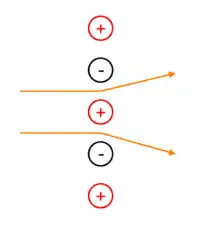Bradbury–Nielsen shutter
A Bradbury–Nielsen shutter (or Bradbury–Nielsen gate) is a type of electrical ion gate, which was first proposed in an article by Norris Bradbury and Russel A. Nielsen, where they used it as an electron filter.[1] Today they are used in the field of mass spectrometry where they are used in both TOF mass spectrometers and in ion mobility spectrometers [2] , as well as Hadamard transform mass spectrometers (a variant of TOF-MS).[3][4] The Bradbury–Nielsen shutter is ideal for injecting short pulses of ions and can be used to improve the mass resolution of TOF instruments by reducing the initial pulse size as compared to other methods of ion injection.

Theory of operation
The concept behind the Bradbury–Nielsen shutter is to apply a high frequency voltage in a 180° out-of-phase manner to alternate wires in a grid which is orthogonal to the path of the ion beam. This results in charged particles only passing directly through the shutter at certain times in the voltage phase (φ=nπ/2), when the potential difference between the grid wires is zero. At other times the ion beam is deflected to some angle by the potential difference between the neighboring wires. This deflection is divergent with ions that pass through alternate slits being deflected in opposite directions. The maximum deflection angle [4] can be calculated by
tan α = k Vp / V0
where α is the deflection angle, k is a deflection constant, Vp is the wire voltage (+Vp on one wire set and -Vp on the other), and V0 is the ion acceleration voltage in eV. The deflection constant k can be calculated by
k = π / 2ln[cot(πR/2d)]
where R is the wire radius and d is the wire spacing.
Micromachined ion gates
A Bradbury-Nielsen Gate micromachined from a silicon on insulator wafer has been reported.[5][6]
References
- Norris E. Bradbury & Russel A. Nielsen (1936). "Absolute Values of the Electron Mobility in Hydrogen". Physical Review. 49 (5): 388–93. Bibcode:1936PhRv...49..388B. doi:10.1103/PhysRev.49.388.
- Szumlas, Andrew W; Hieftje, Gary M (2005). "Design and construction of a mechanically simple, interdigitated-wire ion gate". Rev. Sci. Instrum. AIP. 76 (8). Bibcode:2005RScI...76h6108S. doi:10.1063/1.2006308. Archived from the original on 2011-09-29.
- Joel R. Kimmel; Friedrich Engelke & Richard N. Zare (2001). "Novel method for the production of finely spaced Bradbury–Nielson gates". Review of Scientific Instruments. 72 (12): 4354–4357. Bibcode:2001RScI...72.4354K. doi:10.1063/1.1416109.
- Oh Kyu Yoon; Ignacio A. Zuleta; Matthew D. Robbins; Griffin K. Barbula & Richard N. Zare (2007). "Simple Template-Based Method to Produce Bradbury-Nielsen Gates". Journal of the American Society for Mass Spectrometry. 18 (11): 1901–1908. doi:10.1016/j.jasms.2007.07.030. PMID 17827033.
- Zuleta IA, Barbula GK, Robbins MD, Yoon OK, Zare RN (2007). "Micromachined bradbury-nielsen gates". Anal. Chem. 79 (23): 9160–5. doi:10.1021/ac071581e. PMID 17966990.
- US patent 7176452, Zuleta I., Zare R. & Richard N. Zare, "Microfabricated beam modulation device", issued 2007-02-13, assigned to The Board of Trustees of the Leland Stanford Junior University (Palo Alto, CA)
See also
- Ion mobility spectrometer
- Time-of-flight